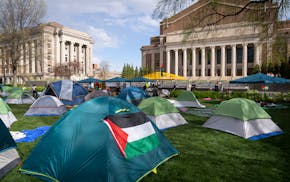SILVER BAY, MINN. — State and local officials, their backs to Lake Superior, pushed golden shovels into a fresh mound of dirt Wednesday morning — a ceremonial groundbreaking for a $25 million residential and recreational development, the largest in this North Shore city since 1954.
Boathouse Bay, the planned development in Bayview Park, is expected to include two dozen three-bedroom villas available for purchase in addition to 18 rental bungalows, all described as having a "rustic modern feel." Twin Cities developer John Anderson has owned this land, which includes 500 feet of shoreline, since the early 2000s.
That was before city leaders began courting tourists to this area along Hwy. 61 between Two Harbors and Grand Marais.
"I don't think Silver Bay is on anyone's radar," Anderson said of the city of almost 2,000, where Cleveland-Cliffs' Northshore Mining is based. "I think it's a fabulous little secret. People are so protective and I think they should be."
Johnson said he expects to begin putting down the foundation for Boathouse Bay in April and to complete the project in the next five years, per an agreement with the city. The purchase price for a home here: low $600,000, according to a sign advertising properties.
Silver Bay's history as an official Minnesota city is relatively short. In the 1950s it was the site of inexpensive housing options built for Reserve Mining Company employees. It was known as the Beaver Bay housing project before it became Silver Bay. Unlike other stops along Hwy. 61, the heart of the city is inland. There are no smoked fish shops, boutiques or restaurants with a Lake Superior vista.
The most substantial building along the water is the mine's processing plant.
Boathouse Bay is northeast of Black Beach, a spot of shoreline colored by taconite tailings that is open to the public. There is a nearby campground with 49 sites situated on nearly 15 acres near the shore. In recent years, North Shore Adventure Park, with its ropes course and ziplines, has popped up nearby in addition to a mini golf course.
The Iron Range Resources and Rehabilitation (IRRR) Board supplied more than $1 million in infrastructure grants for the development project, citing the shortage of housing in this part of the state — and the chance to draw tourism, according to commissioner Ida Rukavina. This will help make the area more competitive and economically viable as a place to live, work, play and invest in, she said from the future construction site.
"The regional housing shortage is a critical economic issue," Rukavina said. "Supply and choice of inventory are currently low, demand is high."
Sen. Grant Hauschild, DFL-Hermantown, said he also hears a lot about housing. People want to live on the North Shore, near the Boundary Waters Canoe Area Wilderness and the Superior National Forest.
"But they don't do it because we don't have the housing," he said. "We don't have the child care, we don't have the core services that we need to ensure that our communities continue to grow and are vibrant."
Supporting this project, he said, was a no-brainer.
Hauschild described the last legislative session as an exciting and impactful one for this part of the state. The session started with extending unemployment benefits for laid off workers at Northshore Mining. He and Rep. Roger Skraba, R-Ely, were behind securing $4 million for the Gitchi-Gami State Trail. In October, Hauschild announced Northland Strong, an initiative that involves connecting with residents and determining their priorities.
Before Anderson put his shovel to dirt, he considered his own changed perspective. He could never understand how people could sit in a lawn chair and just look at the lake. It was for movement: boats, waterskiing.
He's closer to understanding now.
"God's beauty and the majesty of the lake," he said, standing on his plot of land.

Interim University of Minnesota president meets with pro-Palestinian protest organizers

All aboard: Amtrak debuts second train from St. Paul to Chicago on May 21
Suspected gang member charged in fatal shooting of two men nearly 2 years ago in north Minneapolis
Wednesday sentencing for St. Louis Park man who joined ISIS called off, to be rescheduled
